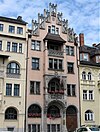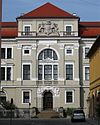Richard-Wagner-Straße (Munich)

The Richard-Wagner-Straße is a street in the Bavarian state capital Munich. It is named after the composer Richard Wagner (1813-1883), who lived in the vicinity of Brienner Straße 37 in 1864-65.
Location[edit]
The short street was built in 1897 in the course of the planned development of Maxvorstadt and forms part of the large right-angled street system of this district. It leads from Brienner Straße in the north-east direction to Gabelsbergerstraße. At about the half way point, it curves.
History[edit]
The houses of the street were built between 1899 and 1906 mostly designed by the architect Leonhard Romeis (1854-1904). In his design, he cited various architectural periods, keeping in mind the taste of late historicism, to give the impression of a grown street. The rich structure of the houses, which is still largely preserved today, creates a particularly picturesque, self-contained area, which stands under monument protection[1] as an ensemble. The eleven preserved historic buildings of this street are also listed as individual monuments under monument protection. More recently are the main administration of the E.ON energy group as well as an urban nursery (No. 14) and a student residence (No. 16).
The proximity to the Königsplatz made the street an address for the upscale bourgeoisie. Joseph Schülein (1854-1938), lived there until his move to Schloss Kaltenberg (No. 7). His son-in-law, the Jewish surgeon Alfred Haas, operated a private clinic (No. 17 and 19). The publisher Fritz Gerlich (1883-1934) lived until his imprisonment and assassination, in house No. 21.
During the period of National Socialism, the Nazi horse racing organization Kuratorium für das Braune Band von Deutschland located in house No. 7. In House No. 11 a so-called Judenhaus was established.
Several institutions have or have had their seat in the street, such as the former Royal College of Art, today the Palaeontological State Collection with the Palaeontological Museum (No. 10), and the Isar Amperwerke, today E.ON.
Buildings[edit]
| No. | function | built | description | image |
|---|---|---|---|---|
| 1 | ||||
| 2 | Back of the Lenbachhaus | |||
| 3 | ||||
| 5 | Apartment house | 1900 | five-storied neo-renaissance building with elevated protrusion tower, by Leonhard Romeis | 
|
| 7 | Residential house | 1901-02 | Four-story neo-gothic building with topped pediment, built by Leonhard Romeis | 
|
| 9 | Apartment house | 1901-02 | three-story neo-renaissance building with relief decor and polygonal tower, by Leonhard Romeis | 
|
| 10 | Bavarian State Collection for Paleontology Geology with the Paläontologisches Museum München | 1899-1902 | representative, three-story, largely free standing new barock block with courtyard, building sculpture and free standing staircase on the south side, by Leonhard Romeis; Construction-time enclosure | 
|
| 11 | Apartment house | 1900-01 | Four-story neo-renaissance building with box bay window and stepped dwarf gypsum, by Leonhard Romeis | 
|
| 13 | Apartment house | 1905 | Four-story neo-renaissance building with saddle roof, box bay window and plastic decor, by Fritz Seidlmair | 
|
| 14 | Municipal Children's Daycare „Friedrich Schiedel“ |
|||
| 15 | Apartment house | 1903-04 | Four-story wide-mounted saddle roof construction with a dwarf gable and historical-tectonic designed plastered facade, by August Zeh, simplified after war damage, restored 1997/98 Facade reconstruction | 
|
| 16 | Student residence of the Van Calker Foundation | 30 student apartments and 3 couples apartments | ||
| 17 | Apartment house | 1910-11 | Four-story art nouveau style building with three-sided longitudinal balconies with elaborate metal grating, by Franz Rank | 
|
| 18 | Apartment house | 1899-1900 | Four-story, mostly freestanding corner building of historicism with tower-like corner formations, by Leonhard Romeis | 
|
| 19 | Residential house | 1910-11 | Four-story art nouveau style building with a rustic ground floor and a longitudinal balcony accessible by two bay windows, by Max Neumann, facade simplified | 
|
| 27 | Apartment house | about 1900 | four-story historical corner building with central box bay window and lateral balconies; Commemorative plaque for Fritz Gerlich, who lived in this house[2] | 
|
References[edit]
- ^ "Grundrisse Haus C" (in German). Brienner Forum. Retrieved 20 April 2017.
- ^ Pfoertner, Helga. Mit der Geschichte leben. Bd. 1 (in German). Munich: Literareron. pp. 144–145. ISBN 3-89675-859-4.
